-
Posts
4,871 -
Joined
-
Last visited
Content Type
Profiles
Forums
Gallery
Events
Posts posted by gjdale
-
-
Best wishes for your upcoming Op, Mark.
I agree with the others re the yellow ochre paint, but don’t rush it - just check under your signature again….the wood is patient…….
- hollowneck, druxey, Rustyj and 5 others
-
 8
8
-
Hey guys, I think we might be drifting a bit here. Unless I've misunderstood, I think HOF was asking for advice on glues with a longer open time, not a quicker setting solution. Apologies if I've got the wrong end of the stick here.
- popeye the sailor, Canute, mtaylor and 1 other
-
 4
4
-
Just as an afterthought HOF, you might consider using Hide glue. I know that Titebond make a ready to use version (no need for heating glue pots). It has a long open time and is easy to use without a lot of mess (no more than white glue anyway). On this side of the ditch its available through Carbatec and other woodworking supply stores.
- mtaylor, popeye the sailor and Canute
-
 3
3
-
You may need to look further than a local hardware store HOF - specialist woodworking stores, or boat building supplies stores (or either on line) will likely be more successful for your search. Look for something that advertises “long open time” or words to that effect.
-
Sorry to hear that Mark - sounds like something I would do! The paint solution sounds like a good plan.
- Jack12477, Old Collingwood, AJohnson and 1 other
-
 4
4
-
5 hours ago, hof00 said:
What adhesive should I use for the Main Deck Veneers? I need to have some "Fiddle" time whilst I align all five or six sections and they are not that small either....
Do you need to be “fiddling” with all five or six sections at once, or can you focus on one section at a time?
I’d be leaning towards the white PVA myself but you can get this in different set times. If you go for one of the slower setting ones, you should be okay.
- BobG, popeye the sailor, mtaylor and 2 others
-
 5
5
-
5 hours ago, Moonbug said:
Choice #1: Accurate & Looks cool - a.k.a. "Whatever Dan Vadas did."
Love it Bug - my sentiments exactly! I’ve lost count of the number of times I’ve referenced back to Danny’s logs to re-read how he did something. That said, I’ve referenced your work on more than one occasion, so don’t sell yourself short. 😊
-
Nice to see you back with a build log Andy. Looks great so far - had a chuckle over the doggy incident!
-
-
The white is looking good Mark - well done.
- Jack12477, Old Collingwood and mtaylor
-
 3
3
-
At the end of the day, they are just numbers so it doesn’t really matter which you use. Where it does make a difference is in tooling - for example a mill or lathe, which will have their lead screws calibrated in either one system or the other (your choice on purchase). In that case, you may need to convert from one measurement system to the other, but then again, if you have a digital readout it again just becomes a matter of dialling in the the right number.
- shipman, VTHokiEE, John Cheevers and 3 others
-
 6
6
-
Thanks Bob,
It’s more difficult to describe than to do. Once you can visualise the completed joint and keep that straight in your head, marking the joint extremities on the second half of the joint is just a matter of being slow and methodical, and triple checking everything before cutting. If the marking out is correct, the joint will be a pretty good fit straight off the cut/pare. If the marking out isn’t accurate, you can end up chasing your tail for quite some time trying to get a good fit. In another log, Druxey suggested practising this joint on some scrap wood first. Good advice - my scrap wood just happened to be additional actual stock…….😉
- usedtosail, BobG and mtaylor
-
 3
3
-
It seems that time has gotten away from me again! Thanks Bob and Tom for your kind comments and for all of the "likes". On with the show!
Hatch (P/N 102)
This is the trickiest part of the build to date. It is made so by the joinery for the hatch, with the Coamings and Head Ledges being joined by “tailed half-lap joints”. This means that the joints are angled in two planes. It took some time to get my head around these joints, and after a few failed attempts I had to walk away for a few days before trying again. Then I got distracted with other tasks around the house and suddenly it was a few weeks before I got back to it.
The key to success here is accurate marking out. To make the first half of the joint, measurements were taken from the drawings. I found my set of set-up blocks most useful for this task, along with a marking knife. The pencil was only used to go over the knife lines to improve their visibility.
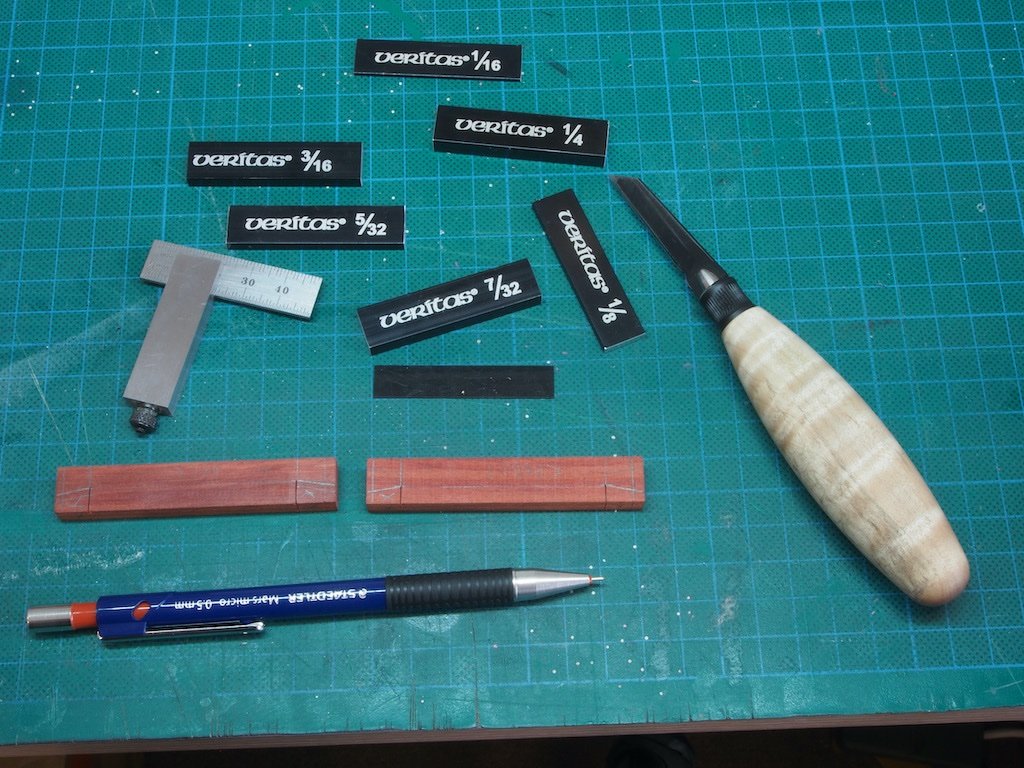
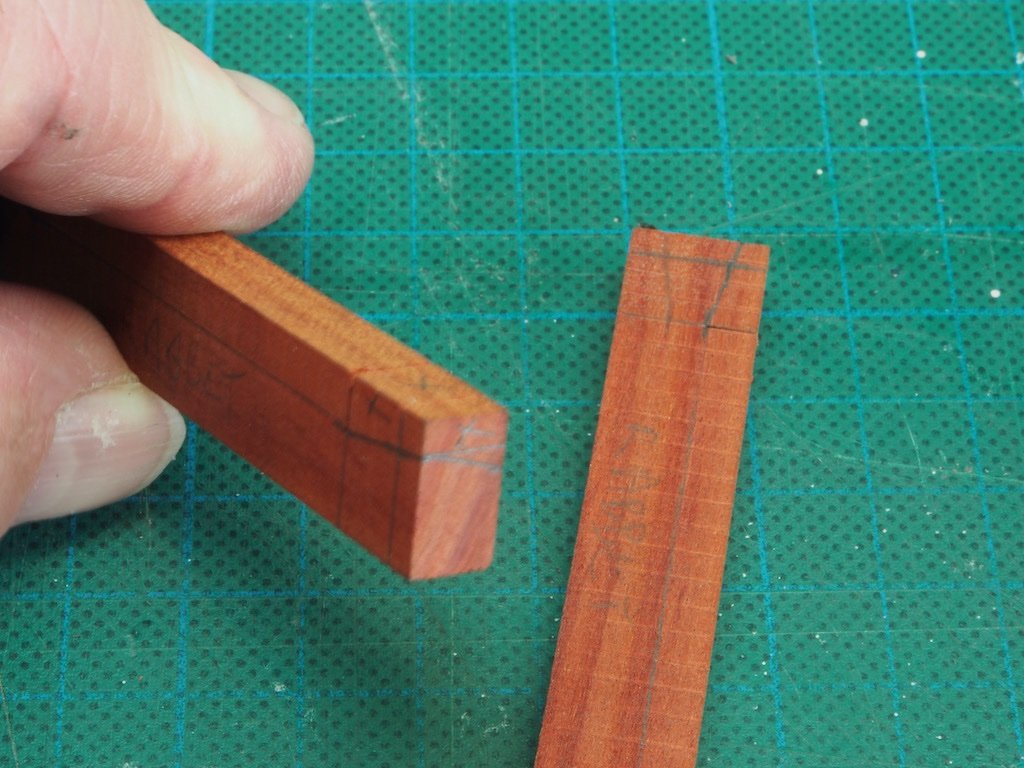
The second half of the joint must be marked directly from the first half, and this is the most difficult part. The method I finally succeeded with was to mark a pin prick with the marking knife to correspond with all four extremities of the first half of the joint. Then it was a case of using a ruler and the knife to “join the dots”. Cutting the joints was achieved with a razor saw and a full size, very sharp chisel. By keeping away from the marked lines initially, I was then able to pare to the line with the chisel and make any minor adjustments for a good fit.
I got so engrossed in this process that I forgot to take any progress shots. Here is an example though of the joints cut, showing the angles in two planes. This picture is actaully of some “rejects”.
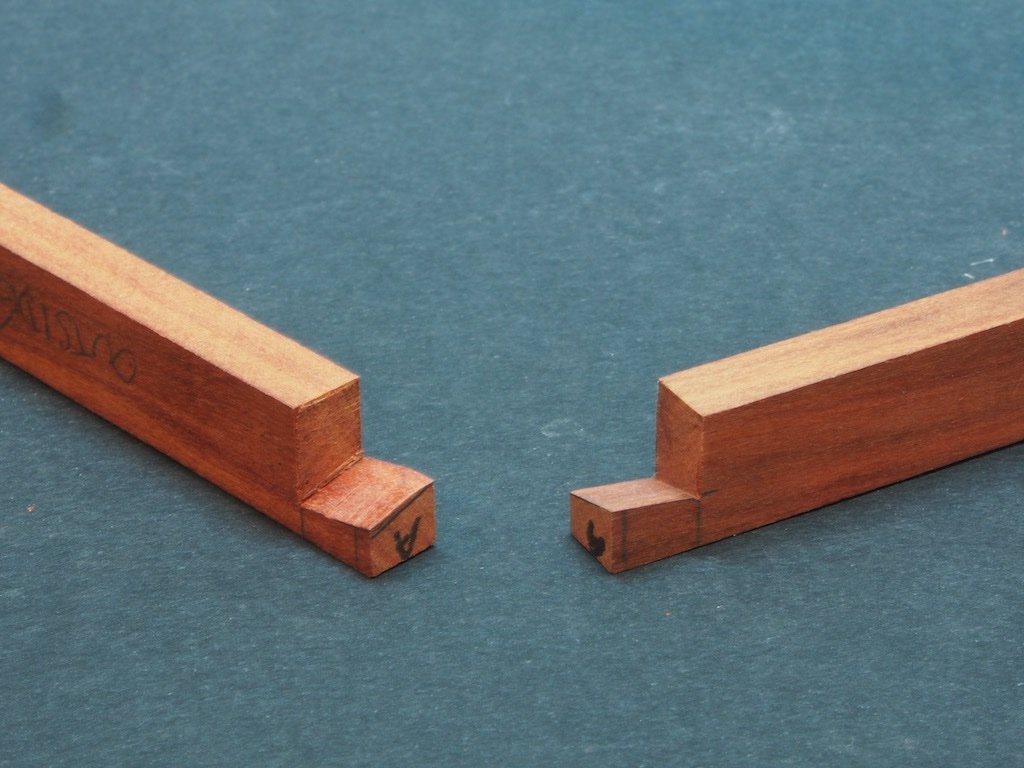
Once I had satisfactory joints in all four corners, they were glued up and the rabbet pieces cut to size and fitted.
The sides of the hatch are vertical for the bottom half, and then taper inwards by one-half inch (actual size). Rather than using a sanding block to achieve this, I used a marking gauge to define the extremities of the taper and then used a block plane to remove the excess material. I used my home-made mini Moxxon vise to hold the piece while I planed the sides, coming in from both ends to avoid breakout on the cross-grain joint.
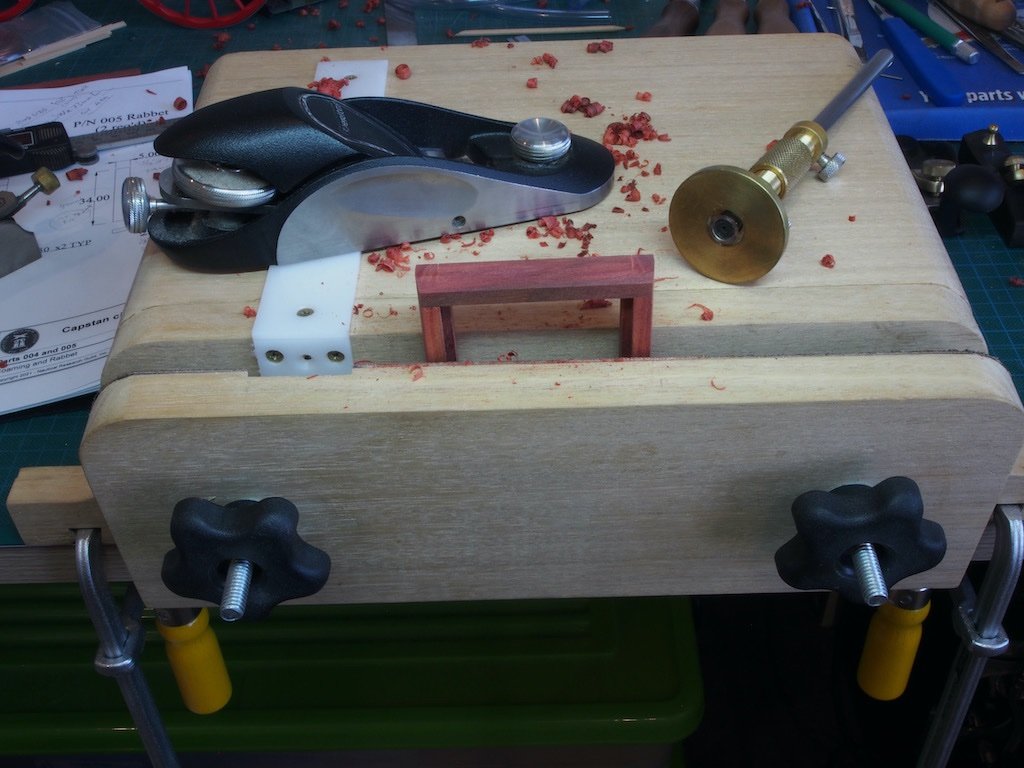
Here is the finished Hatch, ready for installation of the grating.
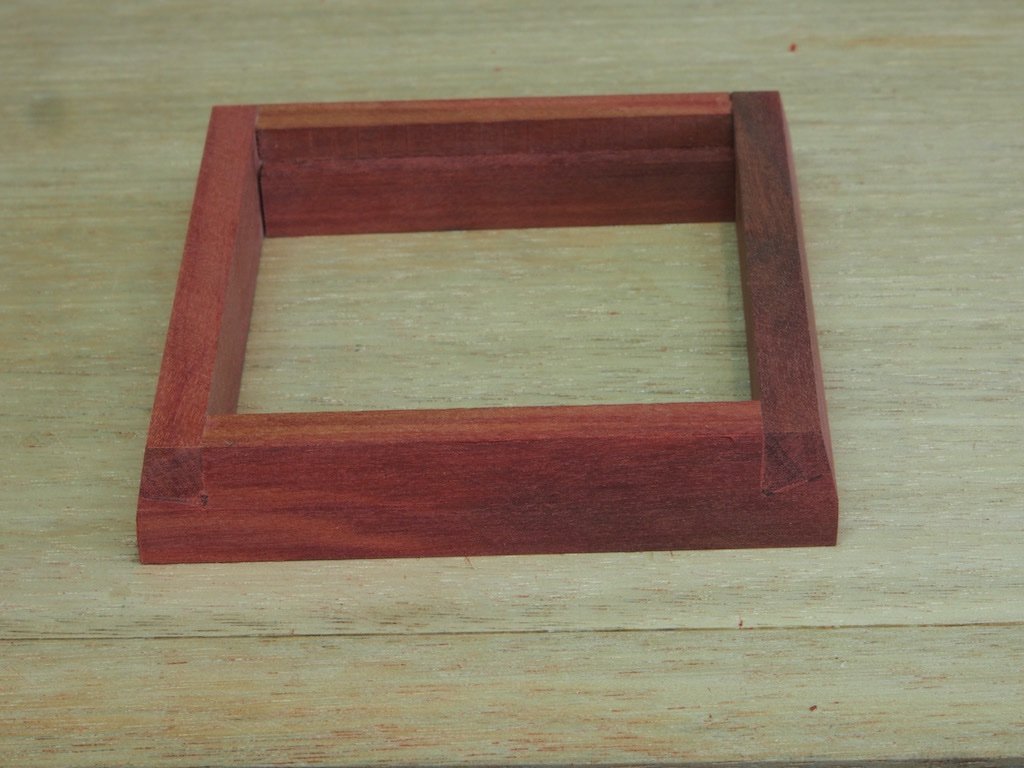
The grating was then carefully adjusted for a snug fit. I found I needed to sand just the slightest amount off each side of the grating. It was then glued in place and the top surface sanded level with the hatch sides.
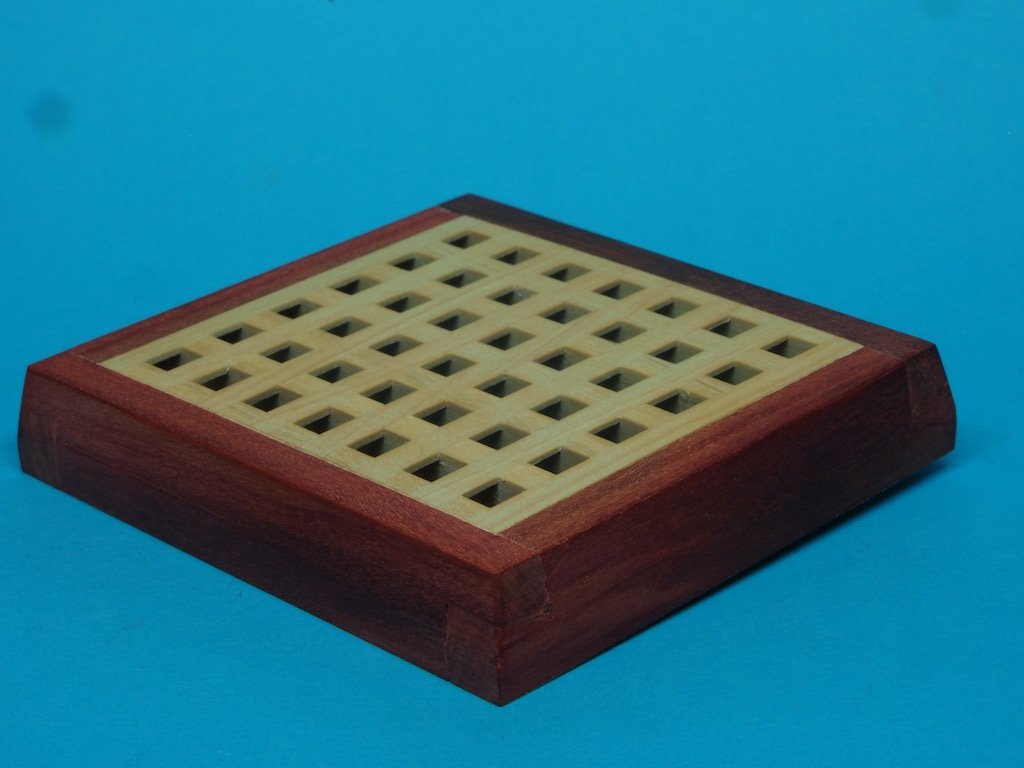
I was contemplating how to mark out the positions for the fasteners, when it hit me that the answer was staring me in the face. I simply cut out the scale drawing of the grating and taped it over my grating. I then used my home-made needle point scribing tool to mark the positions.
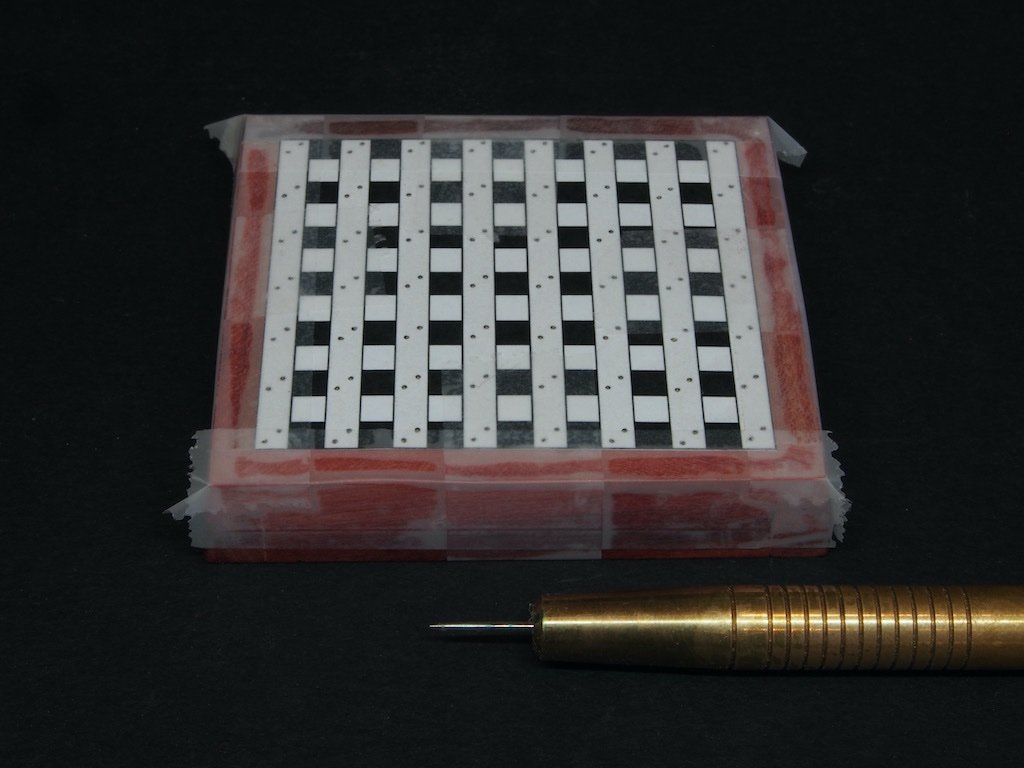
Once the pattern was removed, a pencil lead was twirled in the holes and the surface sanded lightly.
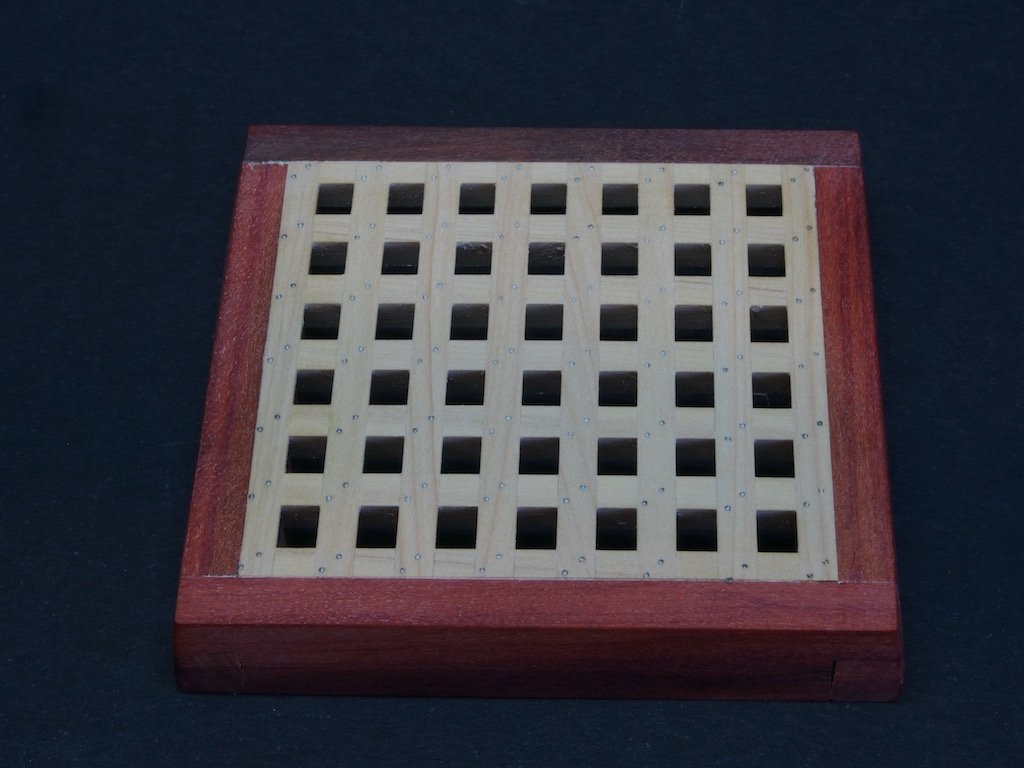
And finally, here is an overview of progress to date:
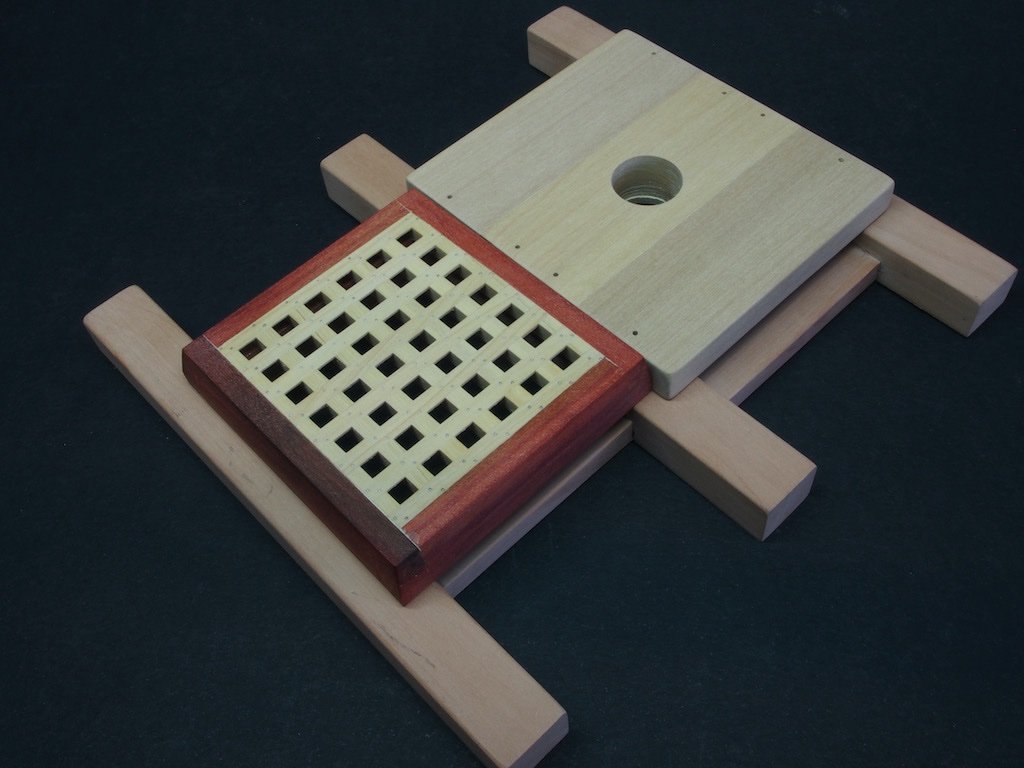
That completes all the “easy” part of this build. Next up we commence some lathe work with building of the Capstan body.
-
I think you’ll find a HUGE interest in a POF kit Chuck. An offering of the quality you have produced with everything you have done so far will be head and shoulders above anything else available on the market today. Add to that your approach to building and documenting as you go (as in Winnie), and I think you will have a real winner on your hands.
- VTHokiEE, FrankWouts, Ryland Craze and 4 others
-
 7
7
-
Pat,
Doesn’t solve your issue with email, but I’ve had good success buying my Sherline bits and pieces through Mike’s Tools in the US. Prices are good and service is prompt.
- mtaylor, BANYAN, Keith Black and 1 other
-
 4
4
-
-
Looks good Floyd. I look forward to seeing the results after tumbling.
-
Hard to believe those parts were created by the same machine! Well done Alan - your perseverance has certainly paid off.
- Old Collingwood, Canute, mtaylor and 2 others
-
 5
5
-
Glad to hear you have found the source of your problems Alan, but not so glad to hear of the poor QC with material choice by the manufacturer. If the filament is that hard, maybe you should 3D print some replacements for the brass part!
- Jack12477, Old Collingwood, mtaylor and 2 others
-
 5
5
-
Beautiful work Ben!
- BobG, Trussben and FrankWouts
-
 3
3
-
Spot on Bug - not sorry at all. 😊
My wife likes the Pocher cars more than my ship models, so she suggested a special display cabinet for them in our dining room. I’m working on the design of this now. I’m being helped by a professional furniture maker with the design process - there appears to be a lot more to it than you might first think!
When I finally get around to building it, I’ll post some pics. Expect to start construction around Xmas time-ish.
- Egilman, hollowneck, BobG and 7 others
-
 10
10
-
Nice model Bug. I still blame you for my own Pocher addiction. In addition to the Alfa Romeo Spider, I now have another three Pocher classic cars to build. And it’s all YOUR fault!!!!!!!! (Oh, did I say, thank you?)
PS My wife has now commissioned me to build a display cabinet specifically for the Pocher cars…….
-
Two steps forward, one step back...
When I measured what would be the final dimensions of my grating, I was disappointed to find that it was significantly out from the drawings and Toni’s dimensions. I think this is a classic example of cumulative error creep. There are 7 Ledges and 8 Battens involved here, so a miniscule dimensional error in either of these soon adds up. I think that a rounding error in the scaling and or conversion to metric might also have been at play. The net result was that I broke out the isopropyl alcohol and disassembled the grating.
I then printed out a scale version of the drawing so that I could overlay the grating on this as I was building it up. The spacing for the Battens seemed fine – meaning that my milling of the notches in the Ledges was okay. I found that by adjusting the spacing between the Ledges by the tiniest amount would result in final dimensions of the right size. After playing around a bit, I found that by using my set-up blocks with a 4.5mm combination gave just the right spacing.
Here is the final result in place on the deck beams. If you look really closely, you can see that the holes in the gratings are not exactly square, but I’m satisfied with the overall appearance. I’ve yet to add the simulated fastenings. In the picture below, you can also see that I’ve drilled the bolt holes in the Capstan Step.
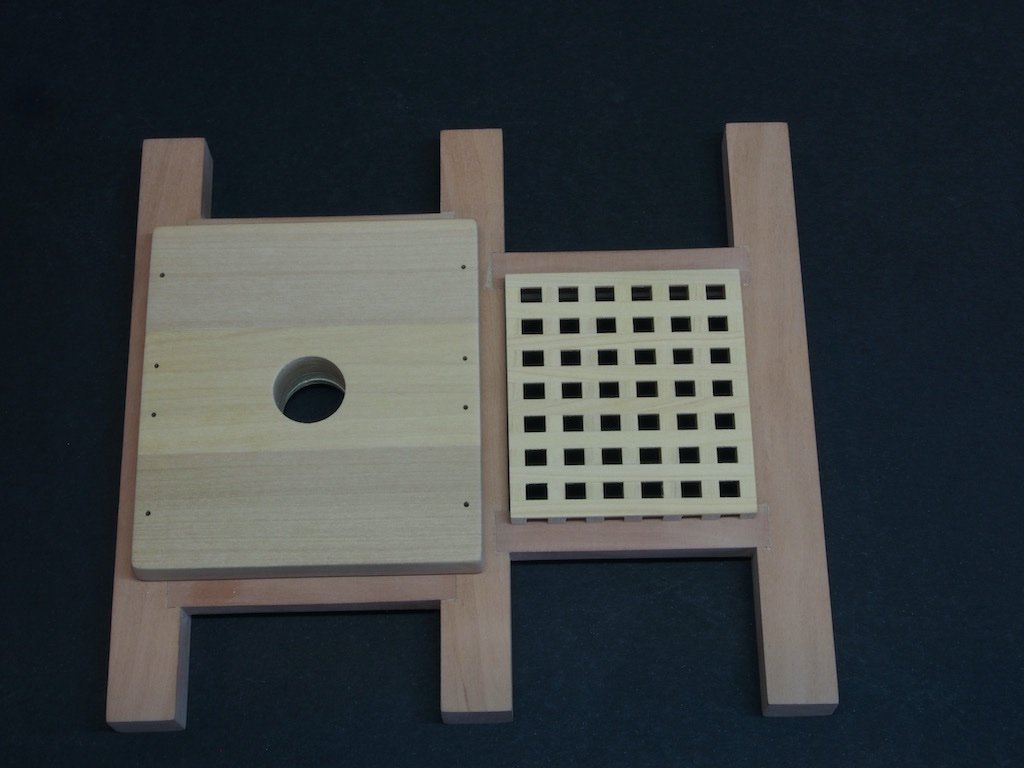
Now I’m ready to face the daunting prospect of the Hatch Coaming and it’s tricky angular joinery….
- JpR62, usedtosail, Ryland Craze and 4 others
-
 7
7
-
Grating (P/N 101)
Although Toni instructs us to make the Hatch Coaming prior to making the grating, I decided to make the grating first and then adjust the size of the Hatch if necessary. I have never scratch built a grating before, so this was to be new territory for me. Toni provides instructions for two methods of making the Ledges (the part with the “teeth”). I chose to follow neither, so what follows is my own take on how to make them.
The Battens (the part that fits into the “teeth” on the Ledges) work out at a scale 5/32” wide x 3/64” thick. This means that the rebate between the teeth, as well as the teeth themselves, must also be 5/32” if we are to achieve a square opening. Fortunately, I happen to have an end mill cutter of 5/32” diameter. Rather than cutting individual strips for the Ledges, then ganging them up to cut the rebates, then separating them again, I decided to cut the rebates into a single piece of stock that was wide enough for the individual Ledge strips to be ripped from later. The stock was also long enough for me to make enough for two sets of ledges.
Prior to cutting the Ledges, I did one test cut in some scrap and then used this as a gauge to fine tune the width of the Battens that were ripped on the Byrnes saw from some 3/64” thick stock.
The mill made short work of this task. By further happy coincidence, 5/32” converts to exactly 4.0mm, which made traversing the mill for each cut a lot easier. I am thankful to have the digital readout though – it made it much harder to stuff it up! I forgot to take some “in process” photos, but here is the result after milling (the rebates are 3/64” (1.2mm) deep).
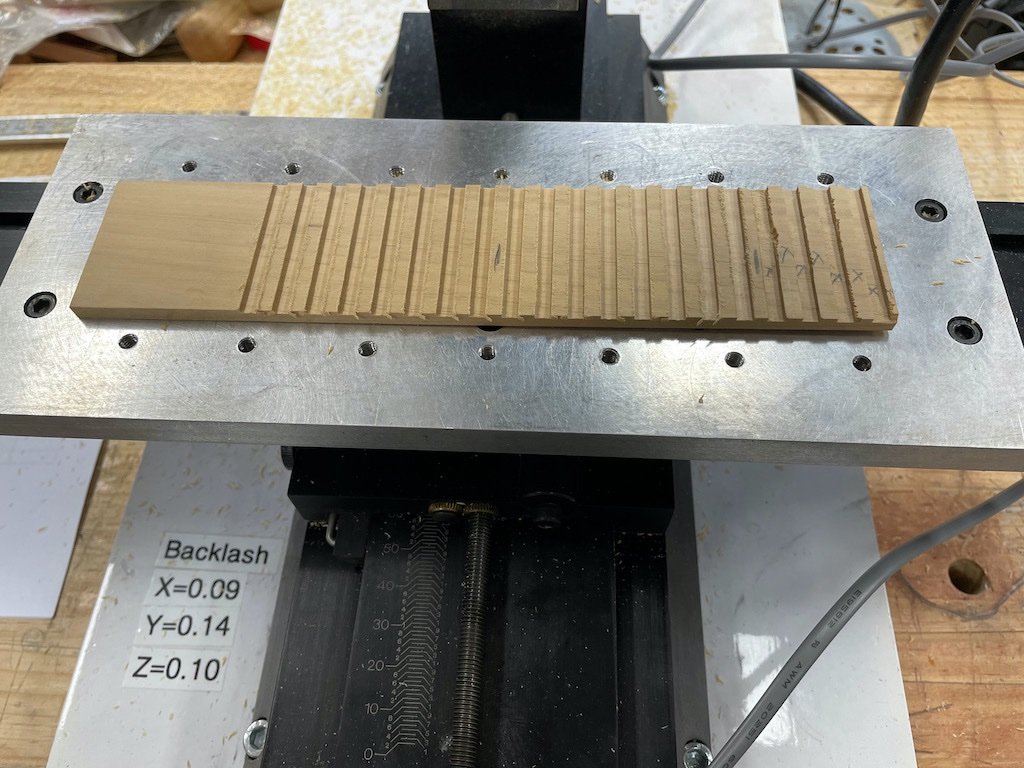
The milling left a little fuzz on the edge of the slots, which was easily cleaned up with a swipe of some 320 grit sandpaper. Here is the cleaned up piece with a batten inserted as a test fit.

This piece was then cross-cut into two sections, each with enough slots for a complete grating. The main reason for doing this was to shorten the length to be ripped as I find that the longer the rip cut, the more likely that binding on the saw blade will occur.
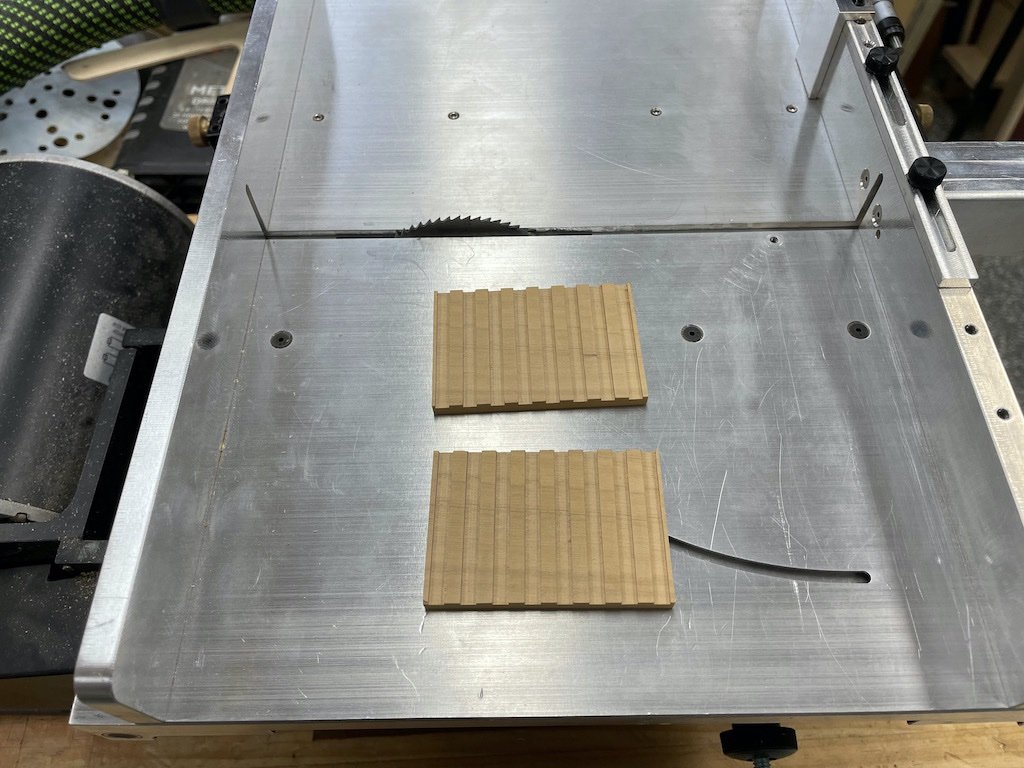
A piece of scrap was used to fine tune the fence setting, then the blocks were ripped into the individual ledge strips. There was sufficient width of stock to rip one spare Ledge from each block. Here are the final Ledges.
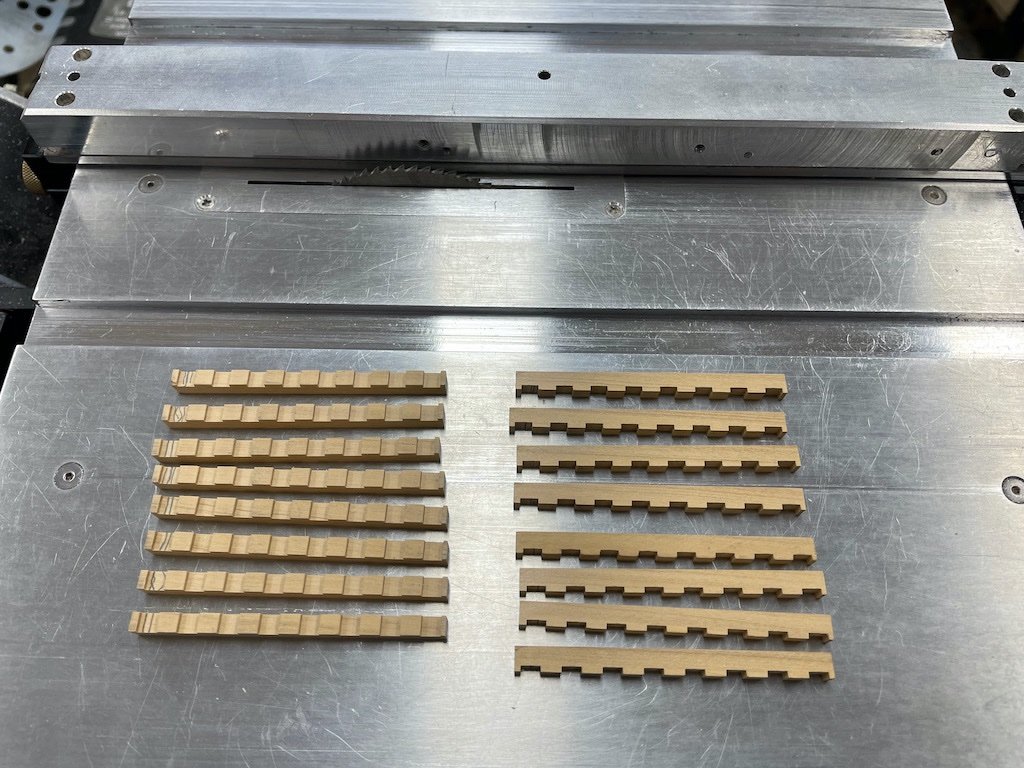
While I had the fence set, I ripped some 3.0mm stock to the same width to use as spacers while assembling the grating.
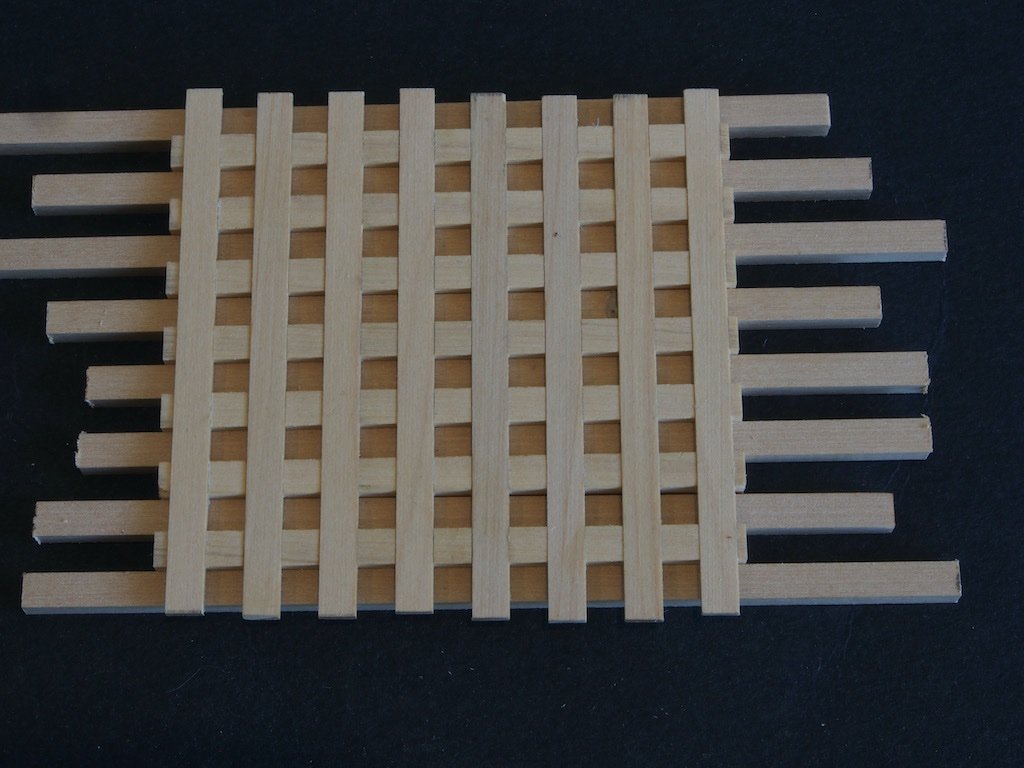
Once I was happy with the dry fit, the Battens were removed one at a time, a drop of glue placed in the rebate and the Batten returned. Once I’d glued all of the Battens, the spacers were removed in case any glue squeeze-out accidentally caught them.
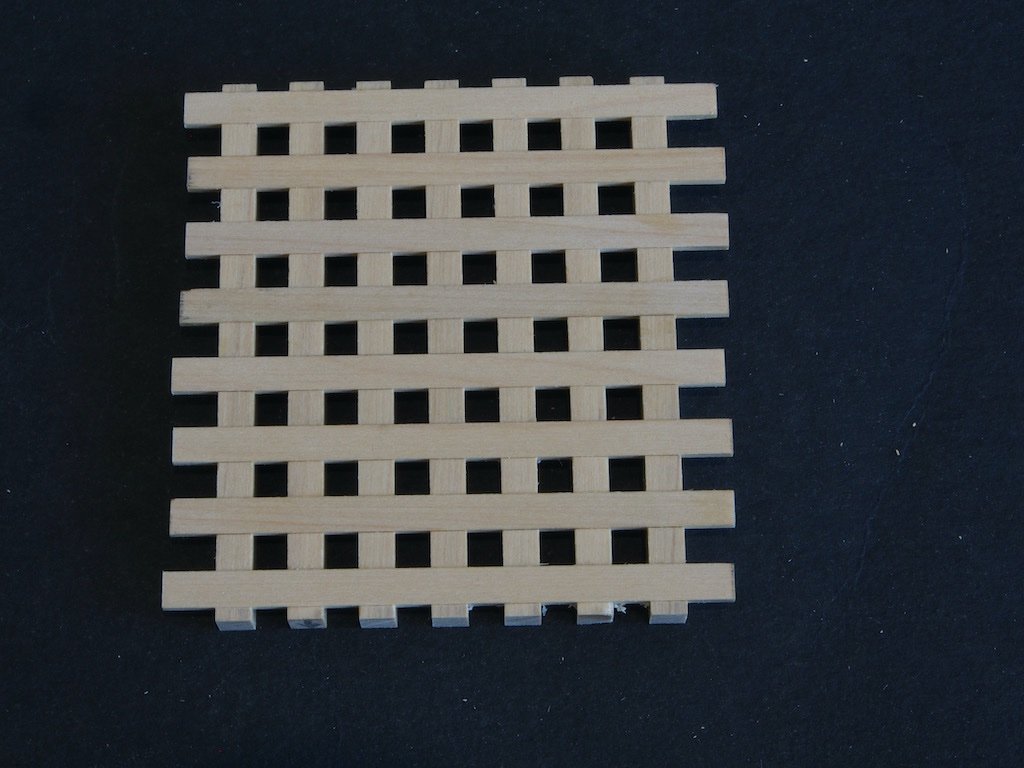
Once the glue has set, I’ll trim the edges on all sides and add the (simulated) fastenings.
Next up, the Hatch Coaming...




Emma C Berry by ahb26 - FINISHED - Model Shipways - 1/32
in - Kit build logs for subjects built from 1851 - 1900
Posted
Very sorry to hear of the loss of your furry friend Andrew. At least you will still have the fond memories of her and Izzy will no doubt be a comfort.
Don’t rush to get back to your model - it will be there when you are ready and you have put far too much hard work into her not to give her the full attention she deserves moving forward. We’ll keep a light on here for you in the meantime.